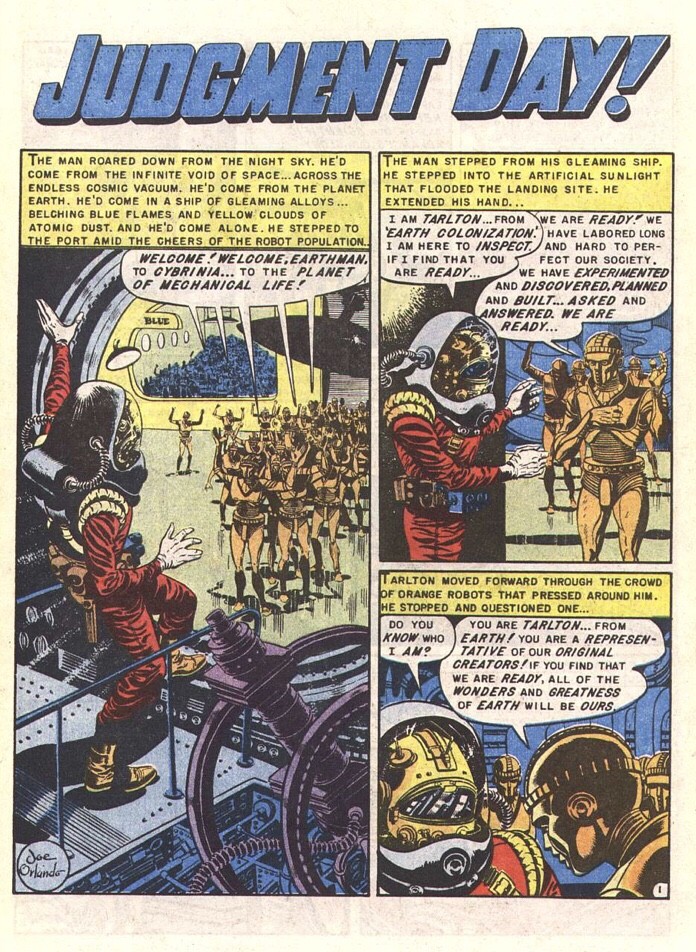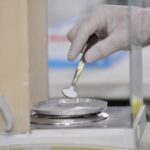EC Comics, particularly the Shock SuspenStories, are known for their realistic and often unsettling narratives. However, delving into their Weird Fantasy series reveals a different approach to social commentary. “Judgement Day,” a story from Weird Fantasy #18 (1953) by Al Feldstein and Joe Orlando, offers a powerful critique of racism and segregation through the lens of science fiction. This article examines how “Judgement Day” uses futuristic allegories to address the deeply rooted issues of discrimination and prejudice.
The story cleverly uses science fiction tropes to address social anxieties of the time, mirroring how gothic literature can reflect fears of societal upheaval. “Judgement Day” uses this framework to give voice to the marginalized and challenge existing power structures, highlighting the story’s enduring relevance.
“Judgement Day” follows Tarlton, a representative from “Earth Colonization,” who visits Cybrinia, “the planet of mechanical life.” His mission is to assess Cybrinia’s readiness for inclusion in Earth’s galactic republic. This premise initially evokes thoughts of assimilation and political recognition, reminiscent of historical experiences of Indigenous peoples and African American communities. However, as the narrative progresses, the story’s core message becomes increasingly evident.
Tarlton is guided by an orange robot through Cybrinia. He is impressed by the seemingly advanced society. The tour includes a visit to an assembly plant where only orange robots are employed to assemble other orange robots. This prompts Tarlton to inquire about the blue robots. The guide’s hesitant response and the use of “their” immediately suggest a division and othering of the blue robots.
The orange robot’s ability to pursue the “American Dream” contrasts sharply with the limitations imposed on the blue robots. The guide reluctantly agrees to take Tarlton to “Blue Town,” located on the south side of the city, mirroring the segregation prevalent in the Jim Crow South and urban North.
At the bus stop, Tarlton observes separate benches for orange and blue robots. He questions the differentiation, and the guide admits that it is necessary to “keep them in their place,” revealing a deep-seated prejudice and fear. This fear is rooted in the false belief that blue robots are inferior and will cause trouble if integrated with orange robots.
On the bus, orange robots sit in the front, while blue robots are relegated to the back. The journey reveals a society structured around segregation. They pass a recharging station exclusively for orange robots, and upon arriving in Blue Town, the buildings appear run-down. Tarlton convinces the guide to enter the blue robot assembly plant with him.
Inside the plant, the assembly process mirrors that of the orange robot plant, except for the robots’ shell color. A blue robot explains that their sheathing limits them to menial jobs, forces them to the back of buses, restricts them to separate recharging stations, and confines them to a specific section of the city. The sheathing symbolizes the arbitrary nature of racial discrimination. The comic highlights how superficial differences can lead to systemic oppression, affecting housing, voting rights, and other essential aspects of life.
Blue robots attend a “blue” educator, which lacks the advantages of the “orange” educator. They do not have the same opportunities. Tarlton confronts the orange robot guide about the injustice, pointing out that segregation affects all aspects of life, including education and environment. The guide’s response, “This existed long before I was made! What can I do about it? I am only one robot!” echoes the excuses of those who benefit from racist systems without actively challenging them.
Tarlton concludes that Cybrinia is not ready to join the galactic republic. When the guide asks if there is any hope, Tarlton reveals that Earth faced similar struggles. He says that real progress began when mankind learned to live together.
As Tarlton flies away, he removes his helmet, revealing himself to be a Black man. The narration emphasizes the perspiration on his “dark skin,” highlighting his personal understanding of the indignity and racism caused by discrimination. His experience informs his judgment: treating individuals differently based solely on skin color is inexcusable.
“Judgement Day” effectively transplants discussions from works addressing real-life racism into a science fiction context. It underscores the absurdity of oppressing individuals based on superficial characteristics and highlights how education and environment shape individuals’ lives. It also conveys the message that even deeply entrenched systems of discrimination can be overcome.
“Judgement Day” prompts readers to reflect on their own biases and positions, demonstrating the power of literature to encourage introspection. By using science fiction as a mirror, the comic challenges readers to confront uncomfortable truths about society and consider the possibility of a more equitable future.


